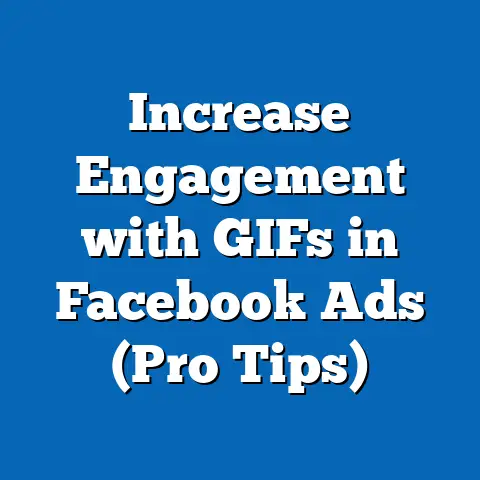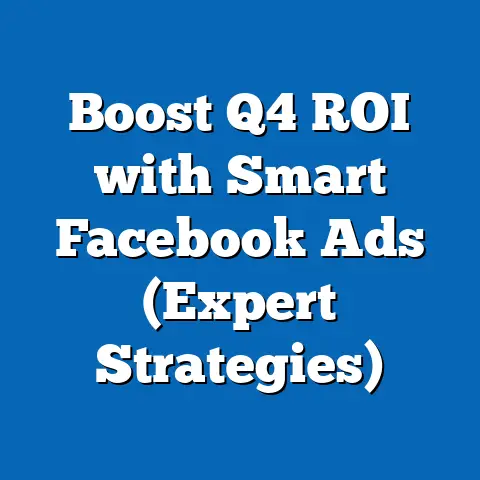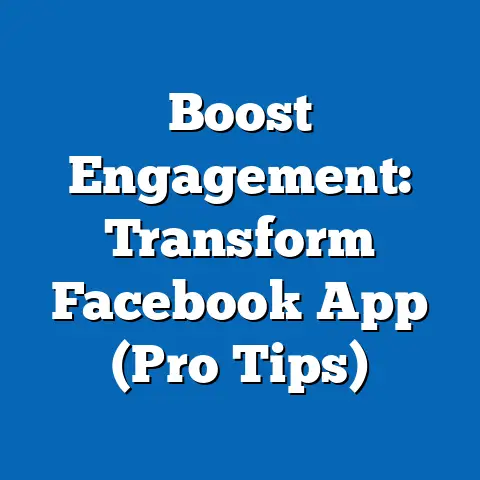Maximize Impact with Facebook CTV Ads (Game-Changer Guide)
Imagine settling into your plush sofa, the ambient lighting just right, as you prepare to indulge in your favorite streaming content. The clarity of the 4K screen, the immersive sound – it’s a luxurious experience. Now, imagine your brand appearing seamlessly within that experience, not as an interruption, but as a natural extension of the high-quality content. That’s the power of Connected TV (CTV) advertising, and when you combine it with the unparalleled targeting capabilities of Facebook, you unlock a game-changer for your brand.
I’ve seen firsthand how CTV ads can elevate a brand’s image, especially when it comes to luxury goods and services. It’s not just about reaching an audience; it’s about reaching the right audience, in the right frame of mind, within an environment that exudes sophistication and exclusivity. Think of it as placing your brand directly into the most upscale living rooms, creating a connection that feels personal and premium.
In this guide, I’ll walk you through everything you need to know to maximize your impact with Facebook CTV ads. We’ll explore the rise of CTV, the specific benefits of using Facebook, how to craft a winning strategy, design compelling ads, measure your success, and even peek into the future of this exciting advertising frontier. Get ready to transform your advertising approach and connect with your audience in a way you never thought possible.
Section 1: Understanding CTV and Its Rise
Connected TV (CTV) refers to televisions that can connect to the internet and stream video content. This includes smart TVs, as well as devices like Roku, Apple TV, Amazon Fire TV, and gaming consoles. It’s more than just watching TV; it’s an interactive, personalized experience.
The rise of CTV has been nothing short of phenomenal. Traditional TV viewership is declining, while CTV is surging. Consider these statistics:
- Growth: CTV ad spend is projected to reach \$27.5 billion in the U.S. by 2025 (eMarketer).
- Reach: Over 80% of U.S. households have at least one connected TV device (Nielsen).
- Engagement: CTV viewers are highly engaged, often watching longer sessions of content than traditional TV viewers (Comscore).
These numbers tell a clear story: consumers are shifting their viewing habits, and advertisers need to follow suit.
CTV Viewers: A Luxury Market Segment
What makes CTV particularly attractive for luxury brands is its demographic profile. CTV viewers tend to be:
- Affluent: They have higher household incomes than traditional TV viewers.
- Educated: They are more likely to hold college degrees.
- Tech-Savvy: They are early adopters of new technologies.
- Decision-Makers: They are often in positions of influence and authority.
This is precisely the audience that luxury brands are trying to reach. They are the consumers who appreciate quality, craftsmanship, and exclusivity. They are willing to pay a premium for products and services that align with their values and aspirations. I’ve seen luxury automotive brands, high-end fashion houses, and even exclusive travel agencies find immense success by targeting this demographic through CTV.
Technological Advancements Fueling CTV’s Growth
The rise of CTV is directly linked to technological advancements:
- Smart TVs: These TVs come equipped with built-in internet connectivity and streaming apps, making it easy for consumers to access a wide range of content.
- Streaming Services: Netflix, Hulu, Amazon Prime Video, Disney+, and countless other streaming services have revolutionized how people consume entertainment.
- Faster Internet Speeds: High-speed internet allows for seamless streaming without buffering or interruptions.
- Advanced Ad Tech: Programmatic advertising platforms enable precise targeting and measurement of CTV ads.
These technological advancements have created a perfect storm for CTV advertising, making it a powerful and effective channel for reaching consumers.
CTV Advertising vs. Traditional TV Advertising
While both CTV and traditional TV advertising involve video ads, there are key differences:
| Feature | CTV Advertising | Traditional TV Advertising |
|---|---|---|
| Targeting | Highly targeted based on demographics, interests, and behavior | Broad reach, limited targeting |
| Interactivity | Interactive ads with clickable CTAs | Passive viewing experience |
| Measurement | Precise tracking of impressions, clicks, and conversions | Limited measurement capabilities, reliance on ratings |
| Cost | Often more cost-effective due to targeted reach | Higher cost per impression, especially during prime time |
| Flexibility | Ability to adjust campaigns in real-time | Limited flexibility, changes require lead time |
| Feature | CTV Advertising | Traditional TV Advertising |
|---|---|---|
| Targeting | Highly targeted based on demographics, interests, and behavior | Broad reach, limited targeting |
| Interactivity | Interactive ads with clickable CTAs | Passive viewing experience |
| Measurement | Precise tracking of impressions, clicks, and conversions | Limited measurement capabilities, reliance on ratings |
| Cost | Often more cost-effective due to targeted reach | Higher cost per impression, especially during prime time |
| Flexibility | Ability to adjust campaigns in real-time | Limited flexibility, changes require lead time |
The ability to target specific audiences and measure results with precision is what sets CTV advertising apart. With traditional TV, you’re essentially casting a wide net and hoping to catch the right fish. With CTV, you can use a laser-guided spear to target the exact fish you want.
Key Takeaway: CTV is not just the future of television; it’s the present. Its growth is driven by technological advancements and changing consumer behavior, making it a powerful channel for reaching affluent, engaged audiences. Understanding the differences between CTV and traditional TV advertising is crucial for crafting an effective strategy.
Next Steps: Research the CTV landscape further. Explore different CTV devices and streaming services. Familiarize yourself with the terminology and key players in the CTV advertising ecosystem.
Section 2: The Benefits of Facebook CTV Ads
Now that we understand the power of CTV, let’s delve into the specific benefits of using Facebook for your CTV advertising campaigns.
Reach, Targeting Precision, and User Data
Facebook offers a unique combination of reach, targeting precision, and access to vast amounts of user data. This makes it an incredibly powerful platform for CTV advertising, especially for luxury brands.
- Reach: Facebook has billions of users worldwide, providing unparalleled reach for your ads.
- Targeting Precision: Facebook’s targeting options are incredibly granular. You can target users based on:
- Demographics: Age, gender, location, education, income, etc.
- Interests: Hobbies, passions, favorite brands, etc.
- Behaviors: Purchase history, online activity, travel habits, etc.
- Custom Audiences: Upload your own customer data to target existing customers or create lookalike audiences.
- User Data: Facebook collects vast amounts of data on its users, providing valuable insights into their preferences and behaviors.
- Demographics: Age, gender, location, education, income, etc.
- Interests: Hobbies, passions, favorite brands, etc.
- Behaviors: Purchase history, online activity, travel habits, etc.
- Custom Audiences: Upload your own customer data to target existing customers or create lookalike audiences.
For example, let’s say you’re a luxury watch brand. You can target Facebook users who are interested in luxury watches, have a high net worth, frequently travel internationally, and have a history of purchasing high-end products online. This level of precision is simply not possible with traditional TV advertising.
I remember working with a luxury car dealership that was struggling to reach its target audience through traditional advertising channels. We implemented a Facebook CTV campaign, targeting users who were interested in high-performance vehicles, had a history of visiting luxury car dealerships, and lived in affluent neighborhoods. The results were astounding. The dealership saw a significant increase in website traffic, leads, and ultimately, sales.
Integration with Facebook’s Ecosystem
One of the biggest advantages of using Facebook for CTV advertising is its integration with the broader Facebook ecosystem. This allows you to create cohesive marketing campaigns that span multiple platforms, including:
- Facebook: Reach users on their Facebook feeds, stories, and in-stream video ads.
- Instagram: Engage users on Instagram with visually appealing images and videos.
- Audience Network: Extend your reach to a network of websites and mobile apps.
- Messenger: Connect with users directly through Messenger ads and chatbots.
By using Facebook’s ecosystem, you can create a consistent brand experience across all touchpoints. This is particularly important for luxury brands, where brand perception and reputation are paramount.
Case Studies: Luxury Brands on Facebook CTV
Let’s look at some examples of successful CTV ad campaigns on Facebook that emphasize luxury brands:
- Example 1: High-End Jewelry Retailer: A high-end jewelry retailer ran a CTV ad campaign on Facebook targeting affluent women who were interested in luxury jewelry. The ads featured stunning visuals of their latest collection and included a call-to-action to visit their website. The campaign resulted in a 30% increase in website traffic and a 15% increase in online sales.
- Example 2: Luxury Travel Agency: A luxury travel agency ran a CTV ad campaign on Facebook targeting affluent individuals who were interested in exotic travel destinations. The ads featured breathtaking video footage of their most popular destinations and included a call-to-action to book a consultation. The campaign resulted in a 25% increase in consultation bookings.
- Example 3: Upscale Home Furnishings Company: An upscale home furnishings company ran a CTV ad campaign on Facebook targeting homeowners with high household incomes who were interested in interior design. The ads featured beautifully designed rooms and included a call-to-action to browse their online catalog. The campaign resulted in a 20% increase in online catalog views and a 10% increase in online sales.
These case studies demonstrate the power of Facebook CTV ads for luxury brands. By leveraging Facebook’s reach, targeting precision, and integration with its ecosystem, luxury brands can achieve significant results.
Key Takeaway: Facebook CTV ads offer unparalleled reach, targeting precision, and integration with a vast ecosystem. This makes it an ideal platform for luxury brands looking to connect with affluent, engaged audiences.
Next Steps: Explore Facebook’s targeting options in detail. Experiment with different targeting combinations to identify your ideal audience. Research successful CTV ad campaigns from luxury brands in your industry.
Section 3: Crafting Your CTV Ad Strategy
Creating a successful CTV ad strategy requires careful planning and execution. Here’s a step-by-step guide to help you get started:
Step 1: Define Your Goals
What do you want to achieve with your CTV ad campaign? Are you looking to:
- Increase brand awareness?
- Drive website traffic?
- Generate leads?
- Boost sales?
Defining your goals is the first step in creating a successful strategy. Your goals will guide your targeting, creative, and measurement efforts.
Step 2: Identify Your Target Audience
Who are you trying to reach with your CTV ads? Consider factors such as:
- Demographics: Age, gender, location, income, education, etc.
- Interests: Hobbies, passions, favorite brands, etc.
- Behaviors: Purchase history, online activity, travel habits, etc.
For luxury brands, it’s particularly important to focus on affluent consumers who appreciate quality and exclusivity.
Step 3: Develop Your Creative Concept
What message do you want to convey with your CTV ads? Your creative concept should be:
- Visually Appealing: Use high-quality imagery and video that captures the attention of your target audience.
- Compelling: Tell a story that resonates with your target audience and highlights the unique benefits of your product or service.
- Relevant: Ensure that your message is relevant to the content that your target audience is watching.
For luxury brands, it’s crucial to maintain brand consistency and create a sense of exclusivity.
Step 4: Choose Your Ad Placement
Where do you want your CTV ads to appear? Facebook offers a variety of ad placements, including:
- In-Stream Video Ads: These ads appear before, during, or after video content on streaming services.
- Overlay Ads: These ads appear as overlays on top of video content.
- Banner Ads: These ads appear as banner ads on CTV devices.
Consider your target audience and creative concept when choosing your ad placement. For luxury brands, in-stream video ads are often the most effective option.
Step 5: Set Your Budget and Schedule
How much are you willing to spend on your CTV ad campaign? Your budget will determine how many people you can reach and how often your ads will appear. Your schedule will determine when your ads will appear.
For luxury brands, it’s often worth investing in a higher budget to ensure that your ads reach a highly targeted audience.
Step 6: Track Your Results
How will you measure the success of your CTV ad campaign? Track metrics such as:
- Impressions: The number of times your ads are displayed.
- Clicks: The number of times people click on your ads.
- Website Traffic: The number of people who visit your website after seeing your ads.
- Leads: The number of people who fill out a form or contact you after seeing your ads.
- Sales: The number of people who purchase your product or service after seeing your ads.
By tracking your results, you can identify what’s working and what’s not, and make adjustments to your strategy as needed.
Audience Segmentation and Targeting for Luxury Brands
Facebook offers a wide range of audience segmentation and targeting options that are particularly useful for luxury brands. Here are some examples:
- Affluent Demographics: Target users with high household incomes, high net worth, and luxury spending habits.
- Luxury Interests: Target users who are interested in luxury brands, high-end products, and exclusive experiences.
- Travel Behaviors: Target users who frequently travel internationally, stay in luxury hotels, and dine at upscale restaurants.
- Custom Audiences: Upload your own customer data to target existing customers or create lookalike audiences.
By using these targeting options, you can ensure that your CTV ads are reaching the right people.
The Creative Aspects of CTV Ads: Storytelling and Visual Aesthetics
The creative aspects of CTV ads are crucial for success. Your ads should be visually appealing, compelling, and relevant.
- Visuals: Use high-quality imagery and video that captures the attention of your target audience. For luxury brands, it’s important to create a sense of elegance and sophistication.
- Messaging: Tell a story that resonates with your target audience and highlights the unique benefits of your product or service. For luxury brands, it’s important to emphasize craftsmanship, exclusivity, and heritage.
- Call-to-Action: Motivate viewers to engage with your brand. Use a clear and concise call-to-action that tells viewers what you want them to do.
Ad Placement and Timing
The placement and timing of your CTV ads can also have a significant impact on their effectiveness. Consider the following:
- Placement: Choose ad placements that are relevant to your target audience and creative concept. For luxury brands, in-stream video ads are often the most effective option.
- Timing: Schedule your ads to appear when your target audience is most likely to be watching CTV. Consider factors such as time of day, day of week, and season.
Key Takeaway: Crafting a successful CTV ad strategy requires careful planning and execution. Define your goals, identify your target audience, develop your creative concept, choose your ad placement, set your budget and schedule, and track your results.
Next Steps: Start planning your CTV ad strategy. Define your goals, identify your target audience, and brainstorm creative concepts. Experiment with different ad placements and targeting options to find what works best for your brand.
Section 4: Designing Compelling CTV Ads
Now, let’s dive deeper into the creative process and explore the elements that make CTV ads truly stand out.
Visuals: The Power of High-Quality Imagery and Video
In the world of luxury, visuals are everything. Your CTV ads need to be visually stunning to capture the attention of your target audience and convey a sense of elegance and sophistication.
- High Resolution: Use high-resolution images and videos that look crisp and clear on large screens.
- Professional Production: Invest in professional video production to ensure that your ads are well-shot, well-edited, and visually appealing.
- Aesthetic Consistency: Maintain a consistent visual aesthetic that aligns with your brand identity.
I’ve seen brands completely transform their image simply by upgrading the quality of their visuals. A blurry, pixelated ad can instantly cheapen a luxury brand, while a beautifully crafted video can elevate it to new heights.
Messaging: Crafting a Message That Resonates
Your message should be carefully crafted to resonate with your target audience and highlight the unique benefits of your product or service.
- Focus on Benefits: Emphasize the benefits of your product or service, rather than just the features. What will your target audience gain by using your product or service?
- Tell a Story: Use storytelling to connect with your target audience on an emotional level. Share stories of how your product or service has helped others or how it can help them achieve their goals.
- Use Language Carefully: Use language that is consistent with your brand identity and that resonates with your target audience. Avoid jargon and technical terms.
For luxury brands, it’s important to emphasize craftsmanship, exclusivity, and heritage. Tell the story of your brand and highlight the unique qualities that set you apart from the competition.
Call-to-Action: Motivating Viewers to Engage
Your call-to-action (CTA) should be clear, concise, and compelling. Tell viewers what you want them to do and make it easy for them to take action.
- Clear and Concise: Use clear and concise language that tells viewers exactly what you want them to do.
- Action-Oriented: Use action verbs that motivate viewers to take action.
- Easy to Find: Make your CTA easy to find on the screen. Use a contrasting color and a large font size.
Examples of effective CTAs for luxury brands include:
- “Visit Our Website”
- “Book a Consultation”
- “Explore Our Collection”
- “Learn More”
Brand Consistency and Storytelling in Luxury Marketing
Brand consistency and storytelling are essential for luxury marketing. Your CTV ads should be consistent with your brand identity and should tell a compelling story that resonates with your target audience.
- Brand Guidelines: Follow your brand guidelines to ensure that your ads are consistent with your brand identity.
- Visual Consistency: Use the same colors, fonts, and imagery in all of your ads.
- Messaging Consistency: Use the same language and tone in all of your ads.
Tell the story of your brand and highlight the unique qualities that set you apart from the competition. Share stories of how your product or service has helped others or how it can help your target audience achieve their goals.
Examples of Successful CTV Ad Creatives from Luxury Brands
Let’s look at some examples of successful CTV ad creatives from luxury brands:
- Example 1: Luxury Watch Brand: A luxury watch brand ran a CTV ad featuring stunning visuals of their latest collection. The ad told the story of the brand’s heritage and craftsmanship and included a call-to-action to visit their website.
- Example 2: High-End Fashion House: A high-end fashion house ran a CTV ad featuring a behind-the-scenes look at their latest fashion show. The ad highlighted the creativity and innovation of the brand and included a call-to-action to explore their collection.
- Example 3: Luxury Travel Agency: A luxury travel agency ran a CTV ad featuring breathtaking video footage of their most popular destinations. The ad told the story of the unique experiences that they offer and included a call-to-action to book a consultation.
These examples demonstrate the power of visuals, messaging, and storytelling in CTV advertising. By creating compelling ads that resonate with your target audience, you can drive significant results for your luxury brand.
Key Takeaway: Designing compelling CTV ads requires a focus on visuals, messaging, and brand consistency. Use high-quality imagery and video, craft a message that resonates with your target audience, and maintain a consistent brand identity.
Next Steps: Analyze successful CTV ad creatives from luxury brands in your industry. Identify the elements that make them effective and brainstorm ideas for your own CTV ads.
Section 5: Measuring Success and ROI
Measuring the success of your Facebook CTV ad campaigns is crucial for understanding what’s working and what’s not. It allows you to optimize your campaigns for maximum ROI.
Key Metrics and KPIs for CTV Ad Campaigns
Here are some key metrics and KPIs (Key Performance Indicators) that marketers should focus on:
- Impressions: The number of times your ads are displayed. This is a basic measure of reach.
- Reach: The number of unique users who have seen your ads. This tells you how many different people you’re reaching.
- Frequency: The average number of times each user has seen your ads. This helps you understand if you’re over-exposing your audience.
- Completion Rate: The percentage of viewers who watched your entire ad. This is a good indicator of engagement.
- Click-Through Rate (CTR): The percentage of viewers who clicked on your ad. This measures the effectiveness of your CTA.
- Website Traffic: The number of people who visit your website after seeing your ads. This shows the direct impact of your ads on website traffic.
- Conversion Rate: The percentage of website visitors who complete a desired action, such as filling out a form or making a purchase. This measures the effectiveness of your ads in driving conversions.
- Cost Per Acquisition (CPA): The cost of acquiring a customer through your CTV ads. This is a key metric for measuring ROI.
- Return on Ad Spend (ROAS): The revenue generated for every dollar spent on your CTV ads. This is the ultimate measure of ROI.
Using Facebook Analytics and Other Tools
Facebook Analytics provides valuable insights into the performance of your CTV ad campaigns. You can use Facebook Analytics to track metrics such as:
- Demographics: The age, gender, and location of your viewers.
- Interests: The interests of your viewers.
- Behaviors: The online activity of your viewers.
- Website Traffic: The number of people who visit your website after seeing your ads.
- Conversions: The number of people who complete a desired action on your website after seeing your ads.
In addition to Facebook Analytics, there are other tools that you can use to track the performance of your CTV ad campaigns, such as:
- Google Analytics: Track website traffic and conversions.
- Third-Party Tracking Platforms: Use third-party tracking platforms to track more detailed metrics, such as viewability and brand lift.
Calculating ROI for CTV Ads
Calculating ROI for CTV ads can be challenging, but it’s essential for justifying your ad spend. Here’s how to calculate ROI:
- Calculate Your Investment: Add up all of the costs associated with your CTV ad campaign, including ad spend, creative production costs, and agency fees.
- Calculate Your Revenue: Determine the revenue generated as a direct result of your CTV ad campaign. This can be challenging to track, but you can use attribution modeling to estimate the revenue generated by your ads.
- Calculate Your ROI: Divide your revenue by your investment.
For example, if you invested \$10,000 in a CTV ad campaign and generated \$20,000 in revenue, your ROI would be 200%.
Justifying Ad Spend for Luxury Brands
Luxury brands often have higher ad spend than other brands. This is because they are targeting a smaller, more affluent audience.
Here are some tips for justifying ad spend for luxury brands:
- Focus on Long-Term Brand Building: Luxury brands are often focused on long-term brand building, rather than short-term sales. Emphasize the value of CTV ads in building brand awareness and creating a positive brand image.
- Target High-Value Customers: Focus on targeting high-value customers who are likely to make repeat purchases.
- Measure ROI Carefully: Track your results carefully and use attribution modeling to estimate the revenue generated by your CTV ads.
Key Takeaway: Measuring the success of your Facebook CTV ad campaigns is crucial for understanding what’s working and what’s not. Track key metrics and KPIs, use Facebook Analytics and other tools, and calculate ROI to justify your ad spend.
Next Steps: Set up tracking for your CTV ad campaigns. Identify the key metrics and KPIs that you want to track and choose the tools that you will use to track them.
Section 6: Future Trends in CTV Advertising
The world of CTV advertising is constantly evolving. Here are some emerging trends to watch:
Facebook’s Evolving Platform
Facebook is continuously updating its platform, adding new features and capabilities for advertisers. Keep an eye on these changes and adapt your strategy accordingly.
- Enhanced Targeting Options: Facebook is constantly improving its targeting options, making it easier for advertisers to reach their ideal audience.
- New Ad Formats: Facebook is experimenting with new ad formats for CTV, such as interactive ads and shoppable ads.
- Improved Measurement: Facebook is working to improve its measurement capabilities for CTV ads, making it easier for advertisers to track ROI.
Augmented Reality (AR) and Virtual Reality (VR)
Augmented reality (AR) and virtual reality (VR) are emerging technologies that have the potential to revolutionize the luxury advertising experience on CTV.
- AR Ads: AR ads can overlay digital images and videos onto the real world, creating an immersive and engaging experience for viewers.
- VR Ads: VR ads can transport viewers to a virtual world, allowing them to experience your product or service in a more immersive way.
Imagine a luxury car brand allowing viewers to virtually test drive their latest model from the comfort of their living room. Or a high-end fashion house allowing viewers to virtually try on their latest collection. The possibilities are endless.
AI and Machine Learning
AI and machine learning are already playing a significant role in CTV advertising, and their influence will only continue to grow.
- AI-Powered Targeting: AI can be used to analyze user data and identify the most relevant audience for your CTV ads.
- AI-Powered Optimization: AI can be used to optimize your CTV ad campaigns in real-time, improving performance and ROI.
- AI-Powered Creative: AI can be used to generate compelling ad creatives that resonate with your target audience.
Key Takeaway: The future of CTV advertising is bright. Keep an eye on emerging trends, such as Facebook’s evolving platform, augmented reality (AR), virtual reality (VR), and AI and machine learning.
Next Steps: Stay informed about the latest trends in CTV advertising. Read industry publications, attend conferences, and experiment with new technologies.
Conclusion
Facebook CTV ads offer a transformative opportunity for luxury brands to connect with affluent, engaged audiences in a sophisticated and immersive environment. By understanding the rise of CTV, leveraging the benefits of Facebook, crafting a winning strategy, designing compelling ads, measuring your success, and staying ahead of emerging trends, you can significantly increase your brand’s impact and engagement.
I’ve seen firsthand how CTV ads can elevate a brand’s image, drive website traffic, generate leads, and ultimately, boost sales. But it’s not just about the technology; it’s about the strategy, the creative, and the execution. It’s about understanding your audience, telling a compelling story, and creating a brand experience that resonates with their values and aspirations.
So, embrace the potential of CTV advertising on Facebook. Elevate your brand’s presence and connect with your audience in an unparalleled manner. The future of luxury marketing is here, and it’s on Connected TV. Now, go forth and create ads that not only capture attention but also capture the essence of your brand, delivering a truly luxurious experience to your audience.






